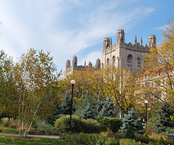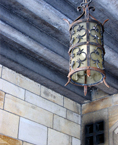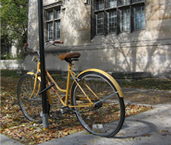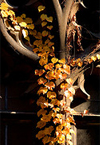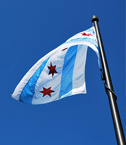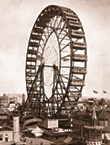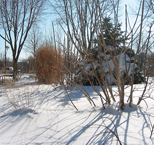The Department of Visual Arts (DOVA) is concerned with the making of art as a vehicle for exploring creativity, expression, perception, and the constructed world. Whether students take courses listed under ARTV to meet a general education requirement or as part of a major in visual arts, the goal is that they will develop communicative, analytical, and expressive skills through the process of artistic production. ARTV 10100 Visual Language: On Images, ARTV 10200 Visual Language: On Objects, and ARTV 10300 Visual Language: On Time and Space are intended for students with no studio background, meet the general education requirement in the dramatic, musical, and visual arts. More advanced courses presume that students have taken at least, ARTV 10200 Visual Language: On Objects, or ARTV 10300 Visual Language: On Time and Space. (See individual course listings for specific prerequisites.)
Introductory courses to the elements of visual communication and the critical investigation of art:
The following courses introduce visual communication through the manipulation of various traditional and nonart materials and also include readings and visits to local museums and galleries. These courses engage principles of visual language stressing the relationship of form and meaning.
ARTV courses numbered 20000 to 29700 include media specific courses that teach technical skills and provide a conceptual framework for working in these media (e.g., painting, photography, sculpture, video). Also included are more advanced studio courses designed to investigate the vast array of objects, spaces, and ideas embedded in the contemporary artistic landscape, selected nonstudio courses in the theory and criticism of art, and courses in theater and set design.
Students in other fields of study may also complete a minor in visual arts. Information follows the description of the major.
The BA program in the Department of Visual Arts is intended for students interested in the practice and study of art. DOVA's faculty consists of a core of artists and other humanists interested in making and thinking about art. Students who major in visual arts take an individually arranged program of studio, lecture, and seminar courses that may include some courses outside the Humanities Collegiate Division. The program seeks to foster understanding of art from several perspectives: the practice and intention of the creator, the visual conventions employed, and the perception and critical reception of the audience. In addition to work in the studio, these aims may require study of art history and intellectual history, as well as psychology, criticism, and aesthetics. Because of the diversity of student interests and the department's interdisciplinary orientation, requirements for the major are flexible.
The Department of Visual Arts encourages its students either to focus their major in the studio or to construct interdisciplinary major programs combining studio and nonstudio courses that focus on a particular theme. The following examples are not prescriptive, only suggestive:
Students majoring in visual arts must receive quality grades for the thirteen courses that constitute the major. With consent of their College adviser and the instructor, nonmajors may take visual arts courses for P/F grades if the courses are not used to meet a general education requirement.
Visual arts students who have a 3.0 or higher overall GPA and a 3.5 or higher GPA for visual arts course work are eligible to be awarded honors. They must also have a portfolio of exceptional quality to be determined by review by the visual arts faculty.
The minor in visual arts requires six courses: two are the 10000-level sequence (ARTV 10100 Visual Language: On Images, ARTV 10200 Visual Language: On Objects, or ARTV 10300 Visual Language: On Time and Space; and ARTV 15000 Art Practice and Theory) and four are drawn from visual arts studio courses chosen in consultation with the Director of Undergraduate Studies. (NOTE: Students minoring in visual arts cannot use an ARTV course to meet the general education requirement in the dramatic, musical, and visual arts.)
Students who elect the minor program in visual arts must meet with the Director of Undergraduate Studies before the end of Spring Quarter of their third year to declare their intention to complete the minor. Students choose courses in consultation with the Director of Undergraduate Studies. The Director's approval for the minor program should be submitted to a student's College adviser by the deadline above on a form obtained from the adviser.
Courses in the minor (1) may not be double counted with the student's major(s) or with other minors; and (2) may not be counted toward general education requirements. Courses in the minor must be taken for quality grades, and more than half of the requirements for the minor must be met by registering for courses bearing University of Chicago course numbers.
Students must attend the first and second classes to confirm enrollment. No exceptions will be made unless the student notifies the instructor before the first class.
Courses
ARTV 10100. Visual Language: On Images. 100 Units.
Through studio work and critical discussions on 2D form, this course is designed to reveal the conventions of images and image-making. Basic formal elements and principles of art are presented, but they are also put into practice to reveal perennial issues in a visual field. Form is studied as a means to communicate content. Topics as varied as, but not limited to, illusion, analogy, metaphor, time and memory, nature and culture, abstraction, the role of the author, and universal systems can be illuminated through these primary investigations. Visits to museums and other fieldwork required, as is participation in studio exercises and group critiques
Terms Offered: Autumn, Winter, Spring
Note(s): ARTV 10100, 10200, and 10300 may be taken in sequence or individually. This course meets the general education requirement in the dramatic, musical, and visual arts. Previous experience in media-based studio courses not accepted as a substitute for this course.
Equivalent Course(s): TAPS 28444
ARTV 10200. Visual Language: On Objects. 100 Units.
Through studio work and critical discussions on 3D form, this course is intended to reveal the conventions of sculpture while investigating its modes of production. Basic formal elements and principles of art are presented, but also put into practice to reveal perennial issues in a visual field. Form is studied as a means to communicate content. Topics as varied as, but not limited to, platonic form, analogy, metaphor, verisimilitude, abstraction, nature and culture, and the body politic can be illuminated through these primary investigations. Visits to museums and other fieldwork required, as is participation in studio exercises and group critiques
Terms Offered: Autumn, Winter, Spring
Note(s): ARTV 10100, 10200, and 10300 may be taken in sequence or individually. This course meets the general education requirement in the dramatic, musical, and visual arts. Previous experience in media-based studio courses not accepted as a substitute for this course.
Equivalent Course(s): TAPS 28445
ARTV 10300. Visual Language: On Time and Space. 100 Units.
Through studio work and critical discussion on four-dimensional form, this course is designed to reveal the conventions of the moving image, performance, and the production of digital-based media. Basic formal elements and principles of art are presented, but also put into practice to reveal perennial issues in a visual field. Form is studied as a means to communicate content. Topics as varied as but not limited to narrative, mechanical reproduction, verisimilitude, historical tableaux, time and memory, the body politic, and the role of the author can be illuminated through these primary investigations. Visits to museums and other fieldwork required, as is participation in studio exercises and group critiques
Terms Offered: Autumn, Winter, Spring
Note(s): ARTV 10100, 10200, and 10300 may be taken in sequence or individually. This course meets the general education requirement in the dramatic, musical, and visual arts. Previous experience in media-based studio courses not accepted as a substitute for this course.
Equivalent Course(s): CMST 10300, TAPS 23400
ARTV 15000. Art Practice and Theory. 100 Units.
This course examines the place of artistic practice in contemporary culture and the rhetoric of images. Emphasis is placed on the visual arts, examining discourses such as the assignment of value to works, the formation of taste, the relationship between individual production and institutional practices, the role of authorship (intentionality) in the construction of meaning, the gate-keeping functions of curatorial and critical practice, the function and maintenance of categorical distinctions constituting "otherness" (high/low, naive, primitive, outside), the relationship between truth and authenticity, and the uses of art (e.g., transcendence, decoration, activism, therapy, play). Visits to museums, galleries, and other cultural and commercial sites required, as is attendance at designated events
Terms Offered: Winter
Note(s): It is recommended that students who are majoring in visual arts enroll in this required course before their fourth year. Open to nonmajors with consent of instructor. This course does not meet the general education requirement in the dramatic, musical, and visual arts.
ARTV 21001. Figure Drawing: Trans/Figuration. 100 Units.
Figure drawing is an experience that engages us visually, physically, emotionally, and psychologically. This many-faceted relationship is examined through the use of a variety of traditional and experimental materials, set-ups, and drawing methods. Assignments and class critiques investigate different models of stylistic invention, ranging from realism to comic expression. This studio class includes readings, field trips, and class projects that address the human form as source for developing your own visual responses to related issues—such as identity, narrative, and social critique
Instructor(s): K. Desjardins Terms Offered: Autumn
Prerequisite(s): ARTV 10100, 10200, or 10300
Equivalent Course(s): ARTV 31001
ARTV 21900. Color Theory and Practice. 100 Units.
This course will introduce students to practical aspects of color mixing and the visual impacts of specific color combinations through a series of studio exercises and projects. Conceptual and theoretical investigations into optics, the science of color, and psychological and symbolic effects will contribute to an overall understanding of color in relation to visual culture and perception
Instructor(s): S. Wolniak Terms Offered: Spring
Prerequisite(s): ARTV 10100, 10200, or 10300
Equivalent Course(s): ARTV 31900
ARTV 22000-22002. Introduction to Painting I-II.
This studio course introduces students to the fundamental elements of painting (its language and methodologies) as they learn how to initiate and develop an individualized investigation into subject matter and meaning. This course emphasizes group critiques and discussion. Courses taught concurrently
ARTV 22000. Introduction to Painting I. 100 Units.
Terms Offered: Autumn, Winter
Prerequisite(s): ARTV 10100, 10200, or 10300
Equivalent Course(s): ARTV 32200
ARTV 22002. Introduction to Painting II. 100 Units.
Terms Offered: Autumn, Winter
Prerequisite(s): ARTV 10100, 10200, or 10300
Equivalent Course(s): ARTV 32202
ARTV 22200. Introduction to Sculpture. 100 Units.
This course introduces the fundamentals of sculptural practice. Building on the historical, aesthetic, and technical strategies of making and thinking about sculpture, students are directed toward the realization of 3D objects. Assignments are intended to explore materials and process so as to facilitate students' development of an idea to a completed object. Discussions and gallery visits help engender an understanding of sculpture within a societal and historical context. Visits to galleries required
Instructor(s): G. Oppenheimer Terms Offered: Winter
Prerequisite(s): ARTV 10100, 10200, or 10300
Note(s): ARTV 24550 recommended
Equivalent Course(s): TAPS 28448,ARTV 32000
ARTV 22300. Sculpture. 100 Units.
This course is a continuation of ARTV 22200 and deepens the student's understanding of the interlocking relations between material, meaning, and culture. As an art form that engages with the same space as the viewer, this class takes up as challenges the eternal sculptural problems of presence, material/cultural value, and embodiment. A specific focus of this class is the relationship between the art object and the cultural environment it is situated in. Context and presentation strategies for art making within and outside of the traditional gallery context are emphasized. Slide presentations, gallery visits, and critical discussion supplement studio work time. Field trips required
Instructor(s): G. Oppenheimer Terms Offered: Spring
Prerequisite(s): ARTV 10100, 10200, or 10300 required; ARTV 22200 and/or ARTV 24550 recommended
Equivalent Course(s): ARTV 32300
ARTV 22501. Digital Imaging. 100 Units.
This studio course introduces fundamental tools and concepts used in the production of computer-mediated artwork. Instruction includes a survey of standard digital imaging software and hardware (i.e., Photoshop, scanners, storage, printing, etc), as well as exposure to more sophisticated methods. We also view and discuss the historical precedents and current practice of media art. Using input and output hardware, students complete conceptually driven projects emphasizing personal direction while gaining core digital knowledge
Instructor(s): J. Salavon Terms Offered: Winter, Spring
Prerequisite(s): ARTV 10100, 10200, or 10300
Equivalent Course(s): ARTV 32501,CMST 28801,CMST 38801
ARTV 22502. Data and Algorithm in Art. 100 Units.
An introduction to the use of data sources and algorithmic methods in visual art, this course explores the aesthetic and theoretical possibilities of computational art-making. Focusing on the diverse and ever expanding global data-feed, we will craft custom software processes to create works investigating the visual transformation of information. Additionally, software programming may be deployed independently, without a connection to source material. While placing an emphasis on creating new work, we will also survey the history of this type of art practice
Instructor(s): J. Salavon Terms Offered: Spring
Prerequisite(s): ARTV 10100, 10200, or 10300
Note(s): No prior experience with programming is necessary.
Equivalent Course(s): ARTV 32502
ARTV 23804. Experimental Animation. 100 Units.
Individually directed video shorts will be produced in this intensive studio course. Experimental and improvised approaches to stop-animation and motion picture art will combine digital production and post-production with analog and material methods of picture making. Early and experimental cinema, puppetry and contemporary low-tech animation strategies will be presented as formal and technical examples
Instructor(s): S. Wolniak Terms Offered: Autumn
Prerequisite(s): ARTV 10100, 10200, or 10300
Equivalent Course(s): ARTV 33804
ARTV 23850. Introduction to Film Production. Units.
This intensive lab introduces 16mm film production, experimenting with various film stocks and basic lighting designs. The class is organized around a series of production situations with students working in crews. Each crew learns to operate and maintain the 16mm Bolex film camera and tripod, as well as Arri lights, gels, diffusion, and grip equipment. The final project is an in-camera edit.
Instructor(s): J. Hoffman Terms Offered: Spring
Equivalent Course(s): ARTV 33850,CMST28920,CMST38920,TAPS 28451
ARTV 23930. Documentary Production I. 100 Units.
This class is intended to develop skills in documentary production so that students may apply for Documentary Production II. Documentary Production I focuses on the making of independent documentary video. Examples of various styles of documentary will be screened and discussed. Issues embedded in the documentary genre, such as the ethics and politics of representation and the shifting lines between fact and fiction will be explored. Pre-production methodologies, production, and post-production techniques will be taught. Students will be expected to develop an idea for a documentary video, crews will be formed, and each crew will produce a five-minute documentary. Students will also be expected to purchase an external hard drive
Instructor(s): J. Hoffman Terms Offered: Autumn
Note(s): Prior or concurrent enrollment in CMST 10100 recommended
Equivalent Course(s): ARTV 33930,CMST 23930,CMST 33930,HMRT 25106,HMRT 35106
ARTV 23931. Documentary Production II. 100 Units.
Over 2 quarters, select students will be immersed in social issue documentary production (note: this course is for 1 credit and meetings will be on average every other week). The requirements for enrollment include Documentary Video I and the consent of the instructor. Students will engage in a series of Kartemquin-led workshops and master classes in advanced documentary production and post-production techniques, and gain insight into the world of contemporary documentary distribution, exhibition, and outreach. The class will meet at the Kartemquin production facilities on the north side of Chicago. Transportation will be provided. Additionally, throughout the two quarters, a number of Kartemquin filmmakers and staff will visit classes in Hyde Park. The end of our two-quarter course will result in a collaboratively produced documentary film, Executive Produced by Award-winning Kartemquin filmmaker Jerry Blumenthal. Course meets Fridays 1-4 in 115 Midway Studios and at Kartemquin Films, 1901 W. Wellington.
Instructor(s): J. Hoffman Terms Offered: Winter, Spring
Prerequisite(s): CMST 23930 or ARTV 23930
Note(s): This course is taught over two quarters.
Equivalent Course(s): ARTV 33931,CMST 23931,CMST 33931
ARTV 24000. Introduction to Black and White Film Photography. 100 Units.
Photography is a familiar medium due to its ubiquitous presence in our visual world, including popular culture and personal usage. In this class, students learn technical procedures and basic skills related to the 35mm camera, black and white film, and print development. They also begin to establish criteria for artistic expression. We investigate photography in relation to its historical and social context in order to more consciously engage the photograph's communicative and expressive possibilities. Course work culminates in a portfolio of works exemplary of the student's understanding of the medium. Field trips required
Terms Offered: Autumn, Winter
Prerequisite(s): ARTV 10100, 10200, or 10300
Note(s): Camera and light meter required.
Equivalent Course(s): ARTV 34000,CMST 27600,CMST 37600
ARTV 24115. Performance Installation I. 100 Units.
This course is designed for students with a background or special interest in any art form to develop “performance installations” by exploring the intersections and boundaries between art forms (i.e., theater, visual art, music, dance, creative writing) and practices that are themselves at the margins of what we think of as art (e.g., martial arts, circus, comic books, new media, graffiti). The work will be collectively created.
Instructor(s): P. Pascoe Terms Offered: Autumn
Note(s): This course may be repeated.
Equivalent Course(s): ARTV 34115,TAPS 28410
ARTV 24116. Performance Installation II. 100 Units.
This course continues ARTV 24115, and is designed for students with a background or special interest in any art form to develop “performance installations” by exploring the intersections and boundaries between art forms (i.e., theater, visual art, music, dance, creative writing) and practices that are themselves at the margins of what we think of as art (e.g., martial arts, circus, comic books, new media, graffiti). The work will be collectively created.
Instructor(s): P. Pascoe Terms Offered: Spring
Prerequisite(s): Consent of instructor
Note(s): ARTV 24115 recommended. This course may be repeated.
Equivalent Course(s): TAPS 28410
ARTV 24201. Collage. 100 Units.
This studio course explores collage as a means for developing content and examining complex cultural and material relationships. Projects and assigned texts outline the history of collage as a dynamic art form with a strong political dimension, as well as critically addressing how it is being used today
Instructor(s): S. Wolniak Terms Offered: Winter
Prerequisite(s): ARTV 10100, 10200, or 10300
Equivalent Course(s): ARTV 34201
ARTV 24202. Art and Everyday Materials. 100 Units.
This course introduces students to the practice of employing non-traditional materials to make 2D and 3D objects. Drawing on the long history of artists who have employed everything from ephemeral to edible materials alongside more traditional media, students will engage the varied techniques and processes of using found objects to make artwork. Assignments are intended to consider every facet of artistic creation, from selection and transformation of materials to the presentation of a completed work. Discussions, readings and required museum visits will reflect on the nature of art and its relationship to life.
Instructor(s): K. Pandian Terms Offered: Autumn
Prerequisite(s): ARTV 10100, 10200, or 10300
Equivalent Course(s): ARTV 34202
ARTV 24301. Writing for Performance. 100 Units.
This course is an exploration of select texts for performance written by performance artists primarily but not entirely operating within the context of art. Via historical context and literary technique, students read, discuss, and analyze texts by various authors spanning the history of performance art: Hugo Ball, John Cage, Richard Foreman, Carolee Schneeman, Joseph Bueys, Karen Finley, Nature Theater of Oklahoma, John Leguizamo, and create and perform their own writing. Field trips and attendance at first class are required
Instructor(s): W. Pope.L Terms Offered: Autumn
Prerequisite(s): ARTV 10100, 10200, or 10300
Equivalent Course(s): ARTV 34301,TAPS 28414
ARTV 24401-24402. Photography I-II.
The goal of this course is to foster investigations and explorations of students in photography (e.g., refine their craft in black and white or color, with a different format camera, or by utilizing light-sensitive materials). Students pursue a line of artistic inquiry by participating in a process that involves experimentation, reading, gallery visits, critiques, and discussions, but mostly by producing images. Primary emphasis is placed upon the visual articulation of the ideas of students through their work, as well as the verbal expression of their ideas in class discussions, critiques, and artist’s statements. Courses taught concurrently and can be repeated as part of an ongoing, developing photographic project
ARTV 24401. Photography I. 100 Units.
Instructor(s): L. Letinsky Terms Offered: Spring
Prerequisite(s): ARTV 10100, 10200, or 10300; and 24000.
Note(s): Camera and light meter required. Courses taught concurrently and can be repeated as part of an ongoing, developing photographic project.
Equivalent Course(s): CMST 27602,CMST 37602,ARTV 34401
ARTV 24402. Photography II. 100 Units.
Instructor(s): L. Letinsky Terms Offered: Spring
Prerequisite(s): ARTV 10100, 10200, or 10300; and 24000.
Note(s): Camera and light meter required. Courses taught concurrently and can be repeated as part of an ongoing, developing photographic project.
Equivalent Course(s): CMST 27702,CMST 37702,ARTV 34402
ARTV 24550. Shopcraft: Methods and Materials. 100 Units.
Designed as a complementary course to the DOVA sculpture sequence, Shopcraft explores the tools and techniques available to students in the wood and metal shop. Topics covered include shop safety; the planning and material selection process for sculpture projects in wood and metal; the care and use of hand tools; interpreting and creating scale drawings and conceptual plans; and basic welding and metal fabricating. A series of small projects designed to challenge and expand students' carpentry and metalworking skills are assigned. In addition, students are invited to incorporate projects from sculpture classes or their individual studio practice into the course
Instructor(s): D. Wolf Terms Offered: Autumn
Prerequisite(s): ARTV 10100, 10200, or 10300
Equivalent Course(s): ARTV 34550,TAPS 27900
ARTV 24703. Mixed-Media Drawing. 100 Units.
An object of your choice will serve as a departure point for this process-oriented studio course that takes you through a sequenced exploration of a variety of mixed media drawing materials, methods, and approaches: from observation to abstraction--to the purely conceptual. Readings, critical writing, and discussion are intended to reinforce fluidity between theory, your ideas, and your art practice. This course is augmented by an image bank and gallery visits
Instructor(s): K. Desjardins Terms Offered: Autumn
Prerequisite(s): ARTV 10100, 10200, or 10300
Note(s): Open to all levels of experience.
Equivalent Course(s): ARTV 34703
ARTV 24704. Large-Scale Drawing. 100 Units.
You will work with a series of projects designed to (literally) expand your definition of drawing. Introduction to a range of strategies: collaboration, re-interpretation, multiplication, site specific installation, among others. Readings and written assignments introduce a historical trajectory that traces drawing on a large scale from prehistoric cave ritual to 20th century institutional critique
Instructor(s): K. Desjardins Terms Offered: Spring
Prerequisite(s): ARTV 10100, 10200, or 10300
Equivalent Course(s): ARTV 34704
ARTV 24705. Drawing from Life, Culture, and Thought. 100 Units.
We will jump into the many ways that drawing can be generated; we will discover the purposes it might serve, and the different forms that it can take. We will explore various ways to generate line, and the relationship between thought and looking
Instructor(s): J. Stockholder Terms Offered: Winter
Prerequisite(s): ARTV 10100, 10200, or 10300
Equivalent Course(s): ARTV 34705
ARTV 24800. Foucault and The History of Sexuality. 100 Units.
This course centers on a close reading of the first volume of Michel Foucault's The History of Sexuality, with some attention to his writings on the history of ancient conceptualizations of sex. How should a history of sexuality take into account scientific theories, social relations of power, and different experiences of the self? We discuss the contrasting descriptions and conceptions of sexual behavior before and after the emergence of a science of sexuality. Other writers influenced by and critical of Foucault are also discussed
Instructor(s): A. Davidson Terms Offered: Autumn
Prerequisite(s): Prior philosophy course or consent of instructor
ARTV 25300. Introduction to Film Analysis. 100 Units.
This course introduces basic concepts of film analysis, which are discussed through examples from different national cinemas, genres, and directorial oeuvres. Along with questions of film technique and style, we consider the notion of the cinema as an institution that comprises an industrial system of production, social and aesthetic norms and codes, and particular modes of reception. Films discussed include works by Hitchcock, Porter, Griffith, Eisenstein, Lang, Renoir, Sternberg, and Welles
Terms Offered: Autumn, Spring
Equivalent Course(s): ARTH 20000,CMST 10100,ENGL 10800
ARTV 25400. Theories of Media. 100 Units.
This course explores the concept of media and mediation in very broad terms, looking not only at modern technical media and mass media but also at the very idea of a medium as a means of communication, a set of institutional practices, and a "habitat" in which images proliferate and take on a "life of their own." Readings include classic texts (e.g., Plato's Allegory of the Cave and Cratylus, Aristotle's Poetics) and modern texts (e.g., Marshall McLuhan's Understanding Media; Regis Debray's Mediology; Friedrich Kittler's Gramophone, Film, Typewriter). We also look at recent films (e.g., The Matrix, eXistenZ) that project fantasies of a world of total mediation and hyperreality. Course requirements include one "show and tell" presentation that introduces a specific medium
Instructor(s): W. J .T. Mitchell Terms Offered: Winter
Prerequisite(s): Any 10000-level ARTH or ARTV course, or consent of instructor
Equivalent Course(s): ARTH 25900,ARTH 35900,CMST 27800,CMST 37800,ENGL 12800,ENGL 32800,AMER 30800
ARTV 26000. Introduction to Stage Design. 100 Units.
This course explores the application of the visual and aural arts to the varied forms of design for the stage (i.e., scenic, lighting, costume, sound). We pay particular attention to the development of a cogent and well-reasoned analysis of text and an articulate use of the elements of design through a set of guided practical projects
Instructor(s): T. Burch Terms Offered: Autumn
Note(s): Lab fee required. This course is offered in alternate years.
Equivalent Course(s): ARTV 36300
ARTV 26210. Food for Thought. 100 Units.
Food and its consumption form essential parts of human experience and play a correspondingly rich role within creative cultural production over millennia—as vehicles for need and desire, purity and danger, value and lack, connection and disruption. This course considers what's at stake when contemporary artists build on this longstanding practice to explore the complexities of current societal, political, and cultural contexts. Works considered range from historical still life painting to recent performative work, with a focus on European and American visual art since 1960. We address recent intertwinings of art and food in relation to relevant theoretical frameworks, art historical contexts, and reception. This co-taught course draws on the instructors' distinct perspectives as artist and curator, and makes use of the Smart Museum's collection and its upcoming exhibition Feast: Radical Hospitality and Contemporary Art (2012). Participation in several field trips and out-of-class film screenings is required. Readings are drawn from a variety of disciplines
Instructor(s): L. Letinsky Terms Offered: Spring
Prerequisite(s): Consent only with preference given to DOVA, Art History, Cultural Studies, Anthropology, and those interested in intersections of food with art, philosophy, literature, culture, and history
Equivalent Course(s): ARTV 36210
ARTV 26212. Embedded. 100 Units.
This class will be a multidisciplinary intensive into the ways in which artistic production is dependent and part of larger cultural tropes. Utilizing contemporary culture as a framework how does art form connective tissues with the world that happens outside of the artist’s studio? Visual art is a communicative form that requires subject matter and this class will investigate the myriad of ways that artists mine culturally meaningful materials, forms, and images as both subject and as palette. Participation in several field trips and out-of-class film screenings is required. Reference materials are drawn from a variety of disciplines and will include William T. Vollmann, Don DeLillo, Hanna Arendt, Woody Allen, and Paul Verhoeven among others
Instructor(s): G. Oppenheimer Terms Offered: Winter
Prerequisite(s): ARTV 10100, 10200, or 10300 and any 200 or 300 level studio art class.
Equivalent Course(s): ARTV 36212
ARTV 26213. Hauntology: Ghosts, Specters and Other Paranormal Phenomena in Contemporary Art and Beyond. 100 Units.
This interdisciplinary seminar will explore: what it means to be haunted, who (or what) it is that does the haunting, the relationship between the living and the dead, and what is contemporary art’s stake in the phantasmic. Particular areas of focus will include ghosts and their role in historical memory, sacred space and/or haunted places, and the various performative gestures we associate with the paranormal. A number of guest speakers from various backgrounds will lecture, lead discussions, and projects. Assignments include weekly readings and two short writing assignments, one on a key thinker on the subject of hauntology, the other a creative writing assignment based on your own ghost story. A final project of your choice can be a traditional research paper (10–12 pages) or a creative project with your choice of medium. Readings include Jacques Derrida, Charles Dickens, Sigmund Freud, Avery Gordon, Tzvetan Todorov, Jan Verwoert, and others. An exhibition from the seminar will be presented in summer 2012 at DOVA Temporary Gallery, produced in collaboration with the Open Practice Committee. Field trips and screenings required.
Instructor(s): Z. Cahill Terms Offered: Spring
Equivalent Course(s): ARTV 36213,ENGL 25949
ARTV 26300. The History of Photography in America. 100 Units.
This course studies in detail the invention of the photographic system as a confluence of art practice and technology. The aesthetic history of photography is traced from 1839 through the present. Special emphasis is placed on the critical writing of P. H. Emerson, Erwin Panofsky, Alfred Stieglitz, Lewis Mumford, Susan Sontag, and Michael Fried
Instructor(s): J. Snyder Terms Offered: Autumn
Prerequisite(s): Any 10000-level ARTH or ARTV course, or consent of instructor
Equivalent Course(s): ARTH 26400,HIPS 25300,ARTV 36300,ARTH 36400
ARTV 26500. History of International Cinema I: Silent Era. 100 Units.
This course introduces what was singular about the art and craft of silent film. Its general outline is chronological. We also discuss main national schools and international trends of filmmaking
Instructor(s): J. Lastra Terms Offered: Autumn
Prerequisite(s): Prior or concurrent enrollment in CMST 10100
Note(s): This is the first part of a two-quarter course. Taking ARTV 26500 and ARTV 26600 in sequence is strongly recommended but not required.
Equivalent Course(s): ARTH 28500,ARTH 38500,CMLT 22400,CMLT 32400,CMST 28500,CMST 48500,ENGL 29300,ENGL 48700,MAPH 33600,ARTV 36500
ARTV 26600. History of International Cinema II: Sound Era to 1960. 100 Units.
The center of this course is film style, from the classical scene breakdown to the introduction of deep focus, stylistic experimentation, and technical innovation (sound, wide screen, location shooting). The development of a film culture is also discussed. Texts include Thompson and Bordwell's Film History: An Introduction; and works by Bazin, Belton, Sitney, and Godard. Screenings include films by Hitchcock, Welles, Rossellini, Bresson, Ozu, Antonioni, and Renoir
Instructor(s): Y. Tsivian Terms Offered: Spring
Prerequisite(s): Prior or concurrent registration in CMST 10100 required; CMST 28500/48500 strongly recommended
Note(s): This is the second part of a two-quarter course. Taking ARTV 26500 and ARTV 26600 in sequence is strongly recommended but not required.
Equivalent Course(s): ARTH 28600,ARTH 38600,CMLT 22500,CMLT 32500,CMST 28600,CMST 48600,ENGL 29600,ENGL 48900,MAPH 33700
ARTV 26750. Chicago Film History. 100 Units.
Students in this course screen and discuss films to consider whether there is a Chicago style of filmmaking. We trace how the city informs documentary, educational, industrial, narrative feature, and avant-garde films. If there is a Chicago style of filmmaking, one must look at the landscape of the city; and the design, politics, cultures, and labor of its people, as well as how they live their lives. The protagonists and villains in these films are the politicians and community organizers, our locations are the neighborhoods, and the set designers are Mies van der Rohe and the Chicago Housing Authority
Instructor(s): J. Hoffman Terms Offered: Spring
Equivalent Course(s): CMST 21801,CMST 31801,ARTV 36750,HMRT 25104,HMRT 35104
ARTV 27200. Painting. 100 Units.
Presuming fundamental considerations, this studio course emphasizes the purposeful and sustained development of a student's visual investigation through painting, accentuating both invention and clarity of image. Requirements include group critiques and discussion
Instructor(s): D. Schutter Terms Offered: Spring
Prerequisite(s): ARTV 10100, 10200, or 10300; and 22000 or 22002
Equivalent Course(s): ARTV 37200
ARTV 27201. Seminar/Independent Projects: Issues in Contemporary Painting. 100 Units.
An introduction to major concerns of contemporary painting through selected readings, lectures, museum/gallery visits, analysis and critical writing. Bi-weekly studio/class critiques of independent and/or assigned studio projects in conjunction with topics addressed in seminar discussions
Instructor(s): K. Desjardins Terms Offered: Winter
Prerequisite(s): ARTV 10100, 10200, or 10300 and 22000 or 22002
Note(s): Visits to museums, galleries, and other cultural and commercial sites required, as is attendance at designated events
Equivalent Course(s): ARTV 37201
ARTV 29600. Junior Seminar. 100 Units.
This seminar prepares students who are majoring in visual arts for their senior project. The project is an independent studio project or a combined studio/research project that students begin in the summer preceding their fourth year. Students engage in two main activities: (1) a series of studio projects challenging the imagination and enlarging formal skills; and (2) an introduction to the contemporary art world through selected readings, lectures, careful analysis of art objects/events, and critical writing. Studio skills are developed while contending with the central task of articulating ideas through a resistant medium. Visits to museums, galleries, and other cultural and commercial sites required, as is attendance at designated events
Instructor(s): S. Wolniak Terms Offered: Spring
Prerequisite(s): Open to nonmajors with consent of Director of Undergraduate Studies.
Note(s): It is recommended that students who are majoring in visual arts enroll in this required course in Spring Quarter of their third year
ARTV 29700. Independent Study in Visual Arts. 100 Units.
Students in this reading course should have already done fundamental course work and be ready to explore a particular area of interest much more closely
Terms Offered: Autumn, Winter, Spring
Prerequisite(s): ARTV 10100 or 10200, and consent of instructor
Note(s): Students are required to submit the College Reading and Research Course Form.
ARTV 29850. Senior Seminar. 100 Units.
This is a critique-based course utilizing group discussion and individual guidance in the service of advancing the senior project for students who are majoring in visual arts. Emphasis is placed on the continued development of student's artistic production that began in the preceding Junior Seminar, and continued throughout the intervening summer. Readings and written responses required. In addition to studio work, visits to museums and galleries required
Instructor(s): S. Wolniak Terms Offered: Autumn
Prerequisite(s): Consent of Director of Undergraduate Studies
Note(s): Required of students who are majoring in visual arts
ARTV 29900. Senior Project. 100 Units.
This course provides an opportunity for students to engage in a sustained and intense development of an independent visual project. This work is then presented as part of an exhibition by graduating seniors. Students work throughout the three quarters with a faculty adviser. They also meet quarterly as a group with all visual arts faculty members to critique their development
Terms Offered: Spring (Autumn and Winter by special arrangement with the department)
Prerequisite(s): Consent of Director of Undergraduate Studies
Note(s): Required of students who are majoring in visual arts. Students are required to submit the College Reading and Research Course Form.

